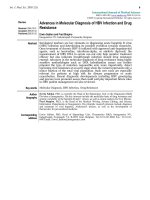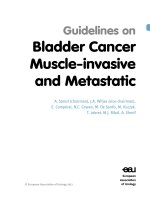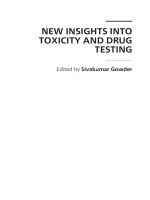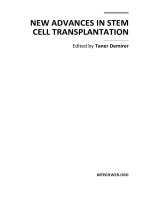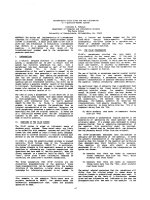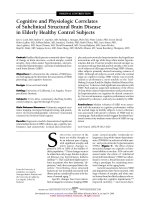GASTRITIS AND GASTRIC CANCER – NEW INSIGHTS IN GASTROPROTECTION, DIAGNOSIS AND TREATMENTS docx
Bạn đang xem bản rút gọn của tài liệu. Xem và tải ngay bản đầy đủ của tài liệu tại đây (21.17 MB, 308 trang )
GASTRITIS AND GASTRIC
CANCER – NEW INSIGHTS
IN GASTROPROTECTION,
DIAGNOSIS AND
TREATMENTS
Edited by Paola Tonino
Gastritis and Gastric Cancer –
New Insights in Gastroprotection, Diagnosis and Treatments
Edited by Paola Tonino
Published by InTech
Janeza Trdine 9, 51000 Rijeka, Croatia
Copyright © 2011 InTech
All chapters are Open Access articles distributed under the Creative Commons
Non Commercial Share Alike Attribution 3.0 license, which permits to copy,
distribute, transmit, and adapt the work in any medium, so long as the original
work is properly cited. After this work has been published by InTech, authors
have the right to republish it, in whole or part, in any publication of which they
are the author, and to make other personal use of the work. Any republication,
referencing or personal use of the work must explicitly identify the original source.
Statements and opinions expressed in the chapters are these of the individual contributors
and not necessarily those of the editors or publisher. No responsibility is accepted
for the accuracy of information contained in the published articles. The publisher
assumes no responsibility for any damage or injury to persons or property arising out
of the use of any materials, instructions, methods or ideas contained in the book.
Publishing Process Manager Martina Blecic
Technical Editor Teodora Smiljanic
Cover Designer Jan Hyrat
Image Copyright Sebastian Kaulitzki, 2010. Used under license from Shutterstock.com
First published September, 2011
Printed in Croatia
A free online edition of this book is available at www.intechopen.com
Additional hard copies can be obtained from
Gastritis and Gastric Cancer – New Insights in Gastroprotection, Diagnosis and
Treatments, Edited by Paola Tonino
p. cm.
ISBN 978-953-307-375-0
free online editions of InTech
Books and Journals can be found at
www.intechopen.com
Contents
Preface IX
Part 1 Pathophysiology of Gastric Mucosal
Defense System and Gastritis 1
Chapter 1 Protective Effects of Gastric Mucus 3
Takafumi Ichikawa and Kazuhiko Ishihara
Chapter 2 Approach to Role of Capsaicin -
Sensitive Afferent Nerves in the Development
and Healing in Patients with Chronic Gastritis 25
Gyula Mozsik, Imre L. Szabo and Andras Dömötör
Chapter 3 Oxidative Stress Pathway Driven
by Inflammation in Gastric Mucosa 47
Dovhanj Jasna and Švagelj Dražen
Chapter 4 Oxidative Stress Involved Autophagy
and Apoptosis in Helicobacter pylori Related Gastritis 63
Jyh-Chin Yang and Chiang-Ting Chien
Part 2 Molecular Pathogenesis
and Treatment of Chronic Gastritis 73
Chapter 5 Chronic Gastritis 75
Wojciech Kozlowski, Cezary Jochymski and Tomasz Markiewicz
Chapter 6 The Role of Morphometry
in Diagnostic of Chronic Gastritis 93
Tomasz Markiewicz, Wojciech Kozlowski and Cezary Jochymski
Chapter 7 Molecular Pathology of Gastritis 115
Alejandro H. Corvalán, Gonzalo Carrasco and Wilda Olivares
Chapter 8 Role of Natural Antioxidants in Gastritis 127
Mohamed M. Elseweidy
VI Contents
Chapter 9 New Approaches in Gastritis Treatment 153
Guillermo Marcial, Cecilia Rodríguez,
Marta Medici and Graciela Font de Valdez
Part 3 Helicobacter Pylori Infection
in Gastritis and Gastric Cancer 177
Chapter 10 Gastric Cancer Risk Diagnosis
and Prevention in Subjects with
Helicobacter pylori-related Chronic Gastritis 179
Shotaro Enomoto, Mika Watanabe, Chizu Mukoubayashi,
Hiroshi Ohata, Hirohito Magari, Izumi Inoue, Takao Maekita,
Mikitaka Iguchi, Kimihiko Yanaoka, Hideyuki Tamai, Jun Kato,
Masashi Oka and Masao Ichinose
Chapter 11 Role of Genetic and Environmental Risk Factors
in Gastric Carcinogenesis Pathway 197
Bárbara Peleteiro and Nuno Lunet
Chapter 12 Effects of Helicobacter pylori Infection on the Histology,
Cellular Phenotype, K-ras Mutations, and Cell Kinetics
in Gastric Intestinal Metaplasia in Patients with
Chronic Gastritis and Gastric Cancer 217
Jiro Watari, Hiroki Tanabe, Kentaro Moriichi, Mikihiro Fujiya,
Peter S. Amenta, Hiroto Miwa, Yutaka Kohgo and Kiron M. Das
Chapter 13 Helicobacter pylori Lipopolysaccharide as
a Possible Pathogenic Factor for Gastric Carcinogenesis 243
Shin-ichi Yokota, Ken-ichi Amano and Nobuhiro Fujii
Chapter 14 Virulence Factors of Helicobacter pylori and Their
Relationship with the Development of Early and Advanced
Distal Intestinal Type Gastric Adenocarcinoma 259
Bruna Maria Roesler, Sandra Cecília Botelho Costa
and José Murilo Robilotta Zeitune
Chapter 15 Role of Gastrokine 1 in Gastric Cancer 281
Emilia Rippa, Paolo Mallardo and Paolo Arcari
Preface
In the last two decades, the research on gastritis, gastroduodenal ulcers and gastric
carcinoma focused on the Helicobacter pylori infection process, but the mechanisms
leading to these diseases are not completely understood. Gastritis is an inflammatory
disease of the gastric mucosa in response to several intrinsic and extrinsic factors. Diet
antigens, extracellular pollutants and pathogenic infections trigger the inflammatory
process in the gastrointestinal tract. Thus, the disruption of the intestinal barrier
results in intestinal inflammation by pro-inflammatory reactions of immune cells. The
inflammatory progression into the gastric lining depends on environmental factors,
host state and H. pylori-specific virulence factors. Albeit the stomach is frequently ex-
posed to hazardous agents, several gastroprotective mechanisms exist to response to
this harsh environment. Furthermore, a better understanding of the mechanisms of
gastric mucosal defense system might provide new insights into potential therapeutic
targets. The modification of functional capsaicin-sensitive afferent nerves also offers
new opportunities in gastroprotective therapy. The severity of gastric inflammation
has also been related to high concentration of free radicals. Chronic inflammation of
the gastric mucosa may predispose susceptible cells to neoplastic transformation. The
reactive oxygen species (ROS, e.g. nitric oxide and superoxide) are key regulatory
factors in molecular pathways linked to carcinogenesis. H. pylori infection increases the
oxidative DNA damage by ROS in epithelial cells as a causal factor in malignant
transformation. Two distinct molecular pathways for gastric carcinogenesis by H.
pylori infection has been proposed; the direct action of the bacterial proteins such as
Cag A on gastric epithelial cells, and the accumulation of genetic and epigenetic
changes in tumor-related genes of the gastric epithelial cells caused by prolonged
bacterial infection and chronic inflammation. Then the identification of novel genes
regulated by H. pylori (cagA, cagT, vacA and dupA) in early stages of gastric cancer
might help to understand the differential susceptibility to this pathogen. Recent
studies have demonstrated the phenotypic and genotypic diversity of H pylori isolates
that may engender differential host inflammatory responses with influence in the
clinical outcome. New strategies for control of H. pylori infection involve the
disruption of the interaction between the bacteria and target cells via downregulation
of apoptosis and upregulation of autophagy.
Besides, the integral analysis of immunohistopathology and overexpression of specific
tumor suppressor genes (e.g. p53 and p73) or a protein secreted by antrum mucosa
X Preface
(gastrokine 1), might be important to the identification of possible biomarkers for the
gastric carcinogenesis. DNA methylated genes have been detected not only in gastric
mucosa but also in the plasma of gastric cancer patients (e.g. Reprimo, RPRM) as a
cell-free DNA, which can be considered a diagnostic tool for non-invasive detection of
premalignant gastritis and gastric cancer. It is also worth to mention that proper
chronic gastritis classification considering both, clinical and histopathological aspects
is fundamental for the diagnosis and successful therapy. Current classification of
gastritis is the 1994 Houston-updated Sydney System. It has been suggested that
digital morphometric evaluation of the inflammatory and epithelial cells of the gastric
mucosa, and the density of neuroendocrine cells in association with chronic gastritis
type, and clinicopathological factors may also be valuable in diagnosis.
The treatment of gastritis depends on the specific cause. In the present, not only
several drugs are in use, but also phytotherapy compounds including tannins and
flavonoids (phenolic compounds) have been associated with healing properties
attributed to the inhibition of cytokine-mediated inflammatory mechanism,
suppression of inducible nitric oxide synthase and antioxidants activities. In addition,
probiotic lactic acid bacteria and probiotic foods might promote beneficial effects on
the gastric mucosa.
Untreated chronic gastritis and other host factors could progress to gastric
carcinogenesis. The model postulated by Correa and Houghton (2007) shows the
combination of H. pylori factors, environmental insults, and the host immune response
involved in the initiation and progression of mucosal atrophy, metaplasia, and
dysplasia toward gastric cancer. It is known that H. pylori eradication changes the
cellular phenotype of gastric intestinal metaplasia, which may be an important factor
in the reduction of cancer incidence.
Recently, H. pylori lipopolysaccharide (LPS) was associated with the enhancement of
the inflammatory reaction and upregulation of the growth rate of epithelial cells via
activation of the MEK1/2-ERK1/2 MAP kinase cascade.
All these aspects are considered in this book, as a comprehensive overview of invited
contributions about gastroprotection, gastritis and gastric carcinogenesis and new
approaches in diagnosis and treatments. The first part of the book covers topics related
to the pathophysiology of gastric mucosal defense system and gastritis including the
gastroprotective function of the mucus, the importance of capsaicin-sensitive afferent
nerves and the oxidative stress pathway involved in inflammation, apoptosis and
autophagy in Helicobacter pylori related gastritis. The next chapters deal with molecular
pathogenesis and treatments, which consider the role of neuroendocrine cells in gastric
disease, DNA methylation in H. pylori infection, the role of antioxidants and
phytotherapy in gastric disease. The final part presents the effects of cancer risk factors
associated with H. pylori infection. These chapters discuss several factors such as, the
serum pepsinogen test, K-ras mutations, cell kinetics, and H. pylori lipopolysaccharide,
as well as the roles of several bacterial genes (cagA, cagT, vacA and dupA) as
Preface XI
virulence factors in gastric cancer, and the gastrokine-1 protein in cancer progression.
The topics presented in this book are suggested to all clinicians and researchers
interested in gastroprotection, gastritis and gastrointestinal cancer diagnosis and
treatments.
I would like to thank the In Tech Publishing team for this opportunity and especially
to all the authors for their contribution to the better understanding of gastritis and
gastric cancer.
August 2011
Dr. Paola Tonino
Associate Professor (UCV),
Venezuela
Part 1
Pathophysiology of Gastric Mucosal
Defense System and Gastritis
1
Protective Effects of Gastric Mucus
Takafumi Ichikawa and Kazuhiko Ishihara
Kitasato University Graduate School of Medical Sciences
Japan
1. Introduction
The gastric mucosa is continuously exposed to many noxious factors and substances. How the
gastric mucosa maintains structural integrity and resists auto-digestion by substances such as
acid and pepsin puzzled clinicians and investigators for more than 200 years. The gastric
epithelium must also resist damage from extrinsic agents, including Helicobacter pylori (H.
pylori) and noxious ingestions such as ethanol and nonsteroidal anti-inflammatory drugs
(NSAIDs). The luminal surface of the stomach is covered by a viscoelastic mucus gel layer that
acts as a protective barrier against the harsh luminal environment. The structural
characteristics of this barrier are primary indicators of its physiological function and changes
of its composition have been identified in gastrointestinal pathologies. This chapter presents
recent insights into the implication of the gastric mucus barrier as “no mucus, no protection”.
While acid, pepsin, and H. pylori are thought to be major factors in the pathophysiology of
gastritis, the importance of the mucosal defense system has also been emphasized. Gastric
‘cytoprotection’ refers to a reduction or prevention of chemically induced acute hemorrhagic
erosions by compounds such as prostaglandin (PG) and SH derivatives without inhibiting
acid secretion in rodents (Robert, 1979; Szabo et al., 1981). Since the concept of
‘cytoprotection’ was introduced, increasing attention has been paid to the effect of
medications on the gastric mucosal defensive mechanisms. Although the exact mechanisms
of the mucosal defense system are unknown, it involves one or more of the naturally
occurring gastric mucosal defensive factors such as mucus metabolism. For estimation of the
gastroprotective function, many drugs have been investigated for their activity to protect the
gastric mucosa from a variety of necrotizing agents such as ethanol and HCl. Considerable
information has accumulated about the gastroprotective function of the mucus that covers
the mucosal surface of the stomach.
2. Fundamental aspects of gastric mucus
2.1 Constituent of gastric mucus
Mucus is produced in mucus-producing cells, secreted and extensively covers the surface
layer of the mucosa by forming a mucus gel layers. As shown in Figure 1, mucus is a
complex mixture containing mucin, water electrolytes, sloughed off cells, enzymes and
various other materials, including bacteria and bacterial products depending on the source
and location of the mucus (Hotta, 2000).
Gastric mucus is present in the mucus granules of the mucus-producing cells, the insoluble
mucus gel layer adhering to the mucosal surface and the gastric lumen in a solubilized
Gastritis and Gastric Cancer – New Insights in Gastroprotection, Diagnosis and Treatments
4
Fig. 1. Composition of gastric mucus.
condition. Mucus rapidly responds to pathological and physiological changes in the
stomach. Moreover, mucus present in the stomach exhibits various actions such as
maintaining lubrication of the mucosal surface, covering ingested foods to mix them,
helping digestion, and protecting the surface epithelium from irritation by forming a thick
mucus gel layer.
Mucin, the major constituent of the mucus, is biosynthesized by the mucus-producing cells
and secreted from them. Mucus-producing cells of the mammalian gastric mucosa are
classified mainly as surface mucus or gland mucus cells (Fig. 2) and respective mucins differ
in their peptide sequences and chemical composition of the carbohydrate moieties. The core
peptides of the mucins from the surface and gland mucus cells of the human stomach are
characterized as MUC5AC and MUC6, respectively. Mucins from these two types of cells
have distinct roles in the physiology of the gastric mucosa. In the studies using experimental
animals, the appearance of specific mucin was observed in the regenerating epithelia during
the healing process from gastric mucosal damage (Hayashida et al., 2001; Ikezawa et al.
2004).
2.2 Outline of gastric mucin
Electron microscopy has indicated 200 to 4000 nm fibers to be present in a gastric mucin
molecule. Mucins are composed of glycoprotein subunits (monomer molecular weight : 3 to
5 x 10
5
) joined by disulfide bridges, to form high-molecular-weight polymers (having a
molecular weight of millions). Each glycoprotein subunit consists of a central peptide core,
with many closely packed carbohydrate side chains attached (Fig. 3). Each carbohydrate
chain is composed of several sugar residues (up to 19 in length) in gastric mucus, and many
will carry a negative charge because of the presence of ester sulfate and sialic acid residues.
It is these negatively charged carbohydrate chains that give the mucin its acidic-staining
Protective Effects of Gastric Mucus
5
Fig. 2. Distribution of cells constituting the oxyntic gland.
Fig. 3. Polymeric structure of mucin molecules.
Gastritis and Gastric Cancer – New Insights in Gastroprotection, Diagnosis and Treatments
6
properties. Each glycoprotein subunit can be divided into two functional regions on the
basis of the peptide core: (1) glycosylated regions in which carbohydrate chains form a
closely packed sheath around the central peptide core, protecting it from proteolytic attack;
and (2) other nonglycosylated regions of the peptide core that have little or no carbohydrate
attached, which are therefore accessible to proteolytic attack by pepsin and other proteolytic
enzymes. These nonglycosylated regions of the peptide core are also the site of the
disulfide bridges that join the glycoprotein subunits together to form the polymeric mucin
structure.
Gel formation between intact polymeric mucin molecules occurs at high concentration (15 to
50 mg/ml) by noncovalent interactions. For gel formation to take place, the mucin must be
in its polymeric form. This is the reason why proteolytic enzymes such as pepsin, which
degrades the mucin polymeric structure, will dissolve mucus gels. Proteolysis digests the
nonglycosylated regions of the peptide core, hence that part containing the disulfide bridges
that join the glycoprotein subunits together. The resulting proteolytically degraded subunit
consists of the glycosylated region, which is resistant to further proteolytic digestion. There
is no detectable loss of carbohydrate during proteolysis and, since it is more than 80% by
weight of the glycoprotein subunit, the proteolytically degraded glycoprotein is still quite
large.
3. Method and tools for mucus research
3.1 Biosynthesis of mucin
Mucin is produced within mucus-producing cells. To serine or threonine in the polypeptide
core synthesized in ribosomes, sugars are transferred one after another in the Golgi
complex. Dekker & Strous (1990) have indicated the biosynthesis of gastric mucin to occur
as follows. A polypeptide (molecular weight: about 270,000) is synthesized in ribosome and
the mucin precursor is synthesized in the rough endoplasmic reticulum (RER). A small
portion of an N-glycoside sugar chain is connected to each end of the peptide in the RER
and is required for efficient oligomerization of the precursor. Three to 4 molecules of this
precursor are polymerized in an ATP-unrelated manner in the RER to form an oligomer. N-
acetylgalactosamine is subsequently transferred to serine and threonine in the late RER
compartment (transitional elements) or in cisternae of the Golgi complex. The three-
dimensional structure of the polypeptide core changes to an elongated random coil as a
result of this transfer. The other sugars are transferred to mucin intermediates before they
can reach the trans-cisternae of the Golgi complex and the mucin intermediates form mature
mucin. Following biosynthesis in mucus-producing cells, mucin accumulates as mucus
granules in the cells and is subsequently secreted through exocytosis. Consequently, a
mucus gel layer is formed, which is degraded or directly secreted (Fig. 4).
3.2 Methods for isolation of gastric mucus
The distribution in the stomach, localization and composition of mucus were mainly
determined by histochemical methods. By virtue of the development of new staining
methods, it has become possible to determine the histochemical characteristics of the
produced mucus. However, this method is not suitable for a quantitative assay to grasp the
disposition of mucus as a whole. To continue our mucus research, the development of some
biochemical assay methods was needed. Gastric mucus is a mixture with a complicated
Protective Effects of Gastric Mucus
7
Fig. 4. Biosynthesis and secretion of mucin on mucus-producing cell.
composition. It is not easy to quantify this substance. To overcome this difficulty, we
decided to determine the major constituent of mucus, mucin, alone for quantitative
evaluation of the gastric mucus. As mucin is a highly glycosylated macromolecule, we
developed a method to efficiently extract and isolate mucin from the gastric mucus and
established the method to quantify its constituent sugars.
Mucus is isolated from corpus and antral mucosa of rat stomach (Fig. 5). To determine
mucus content, lyophilized tissues are subjected to extraction with Tris-HCl buffer
containing 2% Triton X-100 and separated by gel filtration. The first peak eluted with the
void volume is characterized as mucin and the change in mucin content is determined by
measurement of hexose (Azuumi et al., 1980). The amount of hexose per dry tissue weight is
calculated and the results expressed relative to the control. To investigate the biosynthetic
activity of mucin, 2 x 2 mm tissue samples are incubated in a medium containing a labelled
precursor and the mucin fraction is isolated. The radioactivity is determined and given as
levels per tissue protein (Ichikawa et al., 1993).
These biochemical methods are suitable for quantification of the total mucin content in the
entire mucosal layer. With the use of these methods, it became possible to quantify the
amount of mucus and the extent of biosynthesis in each portion of the stomach (corpus and
antrum). Moreover, it became possible to determine the physiological changes and also
changes in the amount of mucus and qualitative changes due to pathological changes such
as an experimental ulcer. However, when using this described method, it was impossible to
determine the disposition of mucin in the mucus gel layer which is important for the gastric
defense mechanism. We normally mechanically scraped the gel layer from the mucosa, and
therefore, it was impossible to make a precise determination due to the loss of surface
epithelial cells. To solve this problem, various methods for removal of the gel layer were
Gastritis and Gastric Cancer – New Insights in Gastroprotection, Diagnosis and Treatments
8
Fig. 5. Preparation of labeled and unlabeled mucus.
tried. As a result, it was confirmed that the mucus gel layer alone can be separated without
damaging the surface epithelium when N-acetylcysteine is used as a mucolytic agent
(Komuro et al., 1991). At present, it has become possible to remove the gel layer, to scrape
the surface mucosa and deep mucosa, and then to determine the mucin content in the
mucus for each region and each layer (Komuro et al., 1992a, 1992b). Our scraping method
enables us to biochemically assess the mucin content of the gel layer by separating it from
the deep mucosa of the stomach, and we have demonstrated that quantitative changes in the
gastric mucin are closely related to mucosal protective activity (Kojima et al., 1992, 1993;
Ichikawa et al., 1994a; Komuro et al., 1998).
3.3 Development of monoclonal antibody against gastric mucin
Previous studies have shown that different types of mucin, differing in their carbohydrates
and core protein structure, are expressed in different regions of the gastrointestinal tract. In
the stomach, the corpus mucin differs from the antral mucin, and in each region the surface-
type mucins (surface mucus cell-type mucins) differ from the gland-type mucins,
synthesized in deeper layers of the gastric mucosa (Corfield et al. 2000). Histochemical
studies revealed that surface-type mucins have different carbohydrate chains from gland-
type mucins in the stomach. For instance, surface-type mucins were stained by galactose
oxidase-cold thionine Schiff (GOTS) staining, while glandular mucins were stained by
paradoxical concanavalin A staining (PCS) (Ota et al., 1991; Ota & Katsuyama, 1992). On the
other hand, studies using gene technology revealed that, in the stomach, the mucin bearing
MUC5AC core protein was expressed in the surface mucosa, while MUC6 was expressed in
the glandular mucosa (De Bolos et al., 1995; Ho et al., 1995a, 1995b; Buisine et al, 2000). The
biochemical characterization of individual mucin molecules is important to understand their
functions, and specific tools to recognize particular mucin species are essential. For these
Protective Effects of Gastric Mucus
9
purposes, many monoclonal antibodies (mAbs) against mucins have been developed and
used in our laboratory (Ishihara et al., 1993). Representative anti-mucin monoclonal
antibodies are shown in Figure 6. The mAbs RGM21 and HIK1083, which recognize a
specific carbohydrate portion of rat gastric surface- and gland-type mucins, respectively
(Ishihara et al., 1996a, 1996b), are frequently used to characterize the different mucin
molecular structures. From histological studies and epitope analyses, the characteristics of
each antibody have been elucidated (Goso et al., 1999, 2003, 2009; Tsubokawa et al., 2007,
2009).
Fig. 6. Representative anti-mucin monoclonal antibodies.
4. Changes of gastric mucus and mucosal protection
4.1 Gastric mucosal protection
The gastric mucosa acts to maintain homeostasis through the physiological mechanism
naturally given to it in the presence of endogenous irritants such as gastric acid, pepsin, and
exogenous irritants such as NSAIDs, stress, and alcohol (Fig. 7). During the protection of the
mucosa, various factors such as bicarbonate ion, mucosal blood flow and cell turnover are
involved other than the mucus. In recent years, the roles played by indirect factors such as
prostaglandin and superoxide dismutase have also been clarified. These factors interact with
each other, and damage to the mucosa occurs through an imbalance between the aggressive
factors and protective factors (Fig. 7).
Gastritis and Gastric Cancer – New Insights in Gastroprotection, Diagnosis and Treatments
10
Fig. 7. Gastric protection: which is stronger, aggressive factor or protective factor?
4.2 Changes of gastric mucus
The response of the gastric mucosa to acute injury is uniform regardless of the damaging
agent; it usually results in exfoliation of the surface epithelium and injury of deeper mucosal
layers. Deep mucosal injury is most likely caused, at least in part, by injury to the gastric
mucosal microvasculature. Acute injury is most often produced by alcohol, aspirin,
indomethacin, and other NSAIDs.
Figure 8 shows the changes of rat gastric mucosa after orally administration of aspirin (100
mg/kg in 0.15N HCl). In the control rat, after fasting for 24 hr, surface mucus cells of the
corpus were strongly stained by RGM21 (Fig. 8a). After the administration of aspirin, the
immunohistochemical reactivity of RGM21 in the corpus of the rat stomach had decreased
when compared with the control situation (Fig. 8b). Figure 8c shows the gastric mucosa
treated with teprenone (geranylgeranylacetone) 3 hr after aspirin administration. Teprenone
is a gastric mucosal protective drug without affecting gastric acid secretion and clinically
used in Japan for treatment of gastritis. This drug has been reported to reveal various
pharmacological actions including the promotion of gastrointestinal mucus (Iwai et al., 2011;
Rokutan et al., 2000).
Protective Effects of Gastric Mucus
11
Fig. 8. Immunohistochemical staining with RGM21 in the gastric mucosa. (a) Normal control
rat. (b) Aspirin (100 mg/kg) was administered orally and lesion formation was assessed 3
hr later. (c) Rat treated with teprenone (200 mg/kg) after aspirin administration.
4.3 Regulatory mechanism of gastric mucus metabolism
It has been elucidated that various factors are involved in the regulation of the mucus
metabolism and each of these factors acts on some specific kind of mucus cells (Fig. 9).
Among the endogenous regulatory factors of the stomach, gastrin, histamine and carbachol,
which have an acid secretory action, EGF and HGF, which are growth factors and PG, which
is an autacoid, are all able to increase the biosynthesis of the gastric mucin. However, a
difference is seen in the mucin synthetic reactions based on these factors. Thus, the increase
in mucin biosynthesis induced by gastrin among these acid secretagogues can be observed
in the surface mucus cells of the gastric oxyntic mucosa, indicating that it occurs by way of
specific gastrin receptors independent of the acid secretion mechanism (Ichikawa et al.,
1993). Moreover, gastrin stimulates the process of glycosylation without any change in the
backbone peptide elongation, and the stimulation is mediated by nitric oxide (NO).
Histamine activates the peptide biosynthesis process of mucin, but this process is not
mediated by NO. On the other hand, carbachol stimulates the biosynthesis of the mucin
peptide as well as the glycosylation step, both in the corpus and the antrum (Ichikawa et al.,
1998). As shown in Figure 9, EGF and HGF have distinct effects on the mucin biosynthesis in
a specific region of gastric mucosa without their trophic effects (Ichikawa et al., 2000a,
2000b). In other words, endogenous regulatory factors act on the mucus-producing cells
through different modes of action, thus regulating their biosynthesis. It has also been
indicated that different regulatory mechanisms are present at various sites in the stomach,
and that NO and neuropeptides are involved in part of the regulatory process (Ichikawa et
al., 2000c).
Gastritis and Gastric Cancer – New Insights in Gastroprotection, Diagnosis and Treatments
12
Fig. 9. Regulation of gastric mucin biosynthesis.
5. Second-generation H
2
-blockers
5.1 Structure of second-generation H
2
-blockers
The H
2
-blockers are widely used these days in the treatment of gastritis. The chemical
structures of some frequently used H
2
-blockers are shown in Figure 10. All the known H
2
-
blockers comprise an aromatic ring with a flexible chain joined to a polar group. Despite
considerable diversity, these compounds can be grouped into two main series according to
the nature of the aromatic rings, namely five-membered and six-membered aromatic ring
series. Cimetidine and ranitidine belong to the conventional group characterized by a five-
membered aromatic ring. Recently, some of the newer H
2
-blockers (so-called second-
generation H
2
-blockers) have been reported to promote the gastric mucosal defense
mechanisms (Fukushima et al., 2006; Harada et al., 2007; Marazova et al. 1998; Murashima et
al., 2009; Saegusa et al., 2008; Ichikawa et al., 2009a). Second-generation H
2
-blockers contain
a six-membered aromatic ring, instead of a five-membered heterocyclic ring.
Of the four H
2
-blockers shown in Figure 10, lafutidine and roxatidine have a stimulant
effect on mucin biosynthesis in the rat gastric mucosa. In contrast, first-generation
H
2
-receptor antagonists such as cimetidine, ranitidine and famotidine, failed to stimulate
mucin biosynthesis (Ichikawa et al., 1994b, 2009b). Second-generation H
2
-blockers,
lafutidine and roxatidine, have been reported to prevent the formation of gastric mucosal
lesions induced by necrotizing agents in rats (Fukushima et al., 2006; Shiratsuchi et al.,
1988), and this effect may be due not only to the inhibition of aggressive factors such as acid,
but also to the maintenance of defensive factors such as mucus. On the other hand, many
reports have indicated that cimetidine and ranitidine lack a protective effect against
necrotizing agent-induced gastric mucosal damage in the rat (Shiratsuchi et al., 1988;
Tarnawski et al., 1985).
Protective Effects of Gastric Mucus
13
Fig. 10. Effects of representative H
2
-blockers on mucin biosynthesis.
5.2 Structure-activity relationship for gastroprotective actions
The above findings have clarified that the second-generation H
2
-blockers have a unique
structure, and not only inhibit acid secretion but also enhance the protective mechanisms of
the gastric mucosa. This should stimulate new interest in the chemical analysis of these
drugs to determine the structural requirements for their gastroprotective actions.
Compared with the structural requirements of the acid-inhibitory mechanisms of the H
2
-
blockers, only a few detailed analyses have been reported of the structural aspects of their
gastroprotective actions (Ichikawa et al., 1996, 1997; Sekine et al., 1998; Hirakawa et al., 1998)
because of the complicated mechanisms of mucosal protection. However, the cardinal
chemical features of lafutidine that determine its mucin biosynthetic activity, as a
quantitative index of its gastroprotective action, were identified by considering the
structural analogs (Fig. 11) of this drug using an rat stomach organ culture system (Ichikawa
et al., 1996). As shown in Figure 11, compounds A, B and C bear the pyridine ring and
compounds D and E bear the furan ring, which are commonly present in the structure of
lafutidine. Mucin biosynthetic activity was increased by the addition of two pyridine
derivatives, lafutidine and compound A. In contrast, compounds D and E, lacking a
pyridine ring, failed to stimulate mucin biosynthesis. Similar results were obtained for
compounds B and C, which have a pyridine ring but lack an amide structure. These results
indicate that pyridine-based compounds containing an amide structure may be essential for
activating the gastroprotective function. Furthermore, comparison with the H
2
-receptor
antagonistic activities of these compounds suggests that H
2
-receptor antagonism is not
directly correlated with lafutidine-induced stimulation of mucin biosynthesis.
A more detailed analysis has been performed using roxatidine and its structural analogs to
reveal the structural requirements of second-generation H
2
-blockers for the stimulant effect
on rat gastric mucin biosynthesis, particularly with regard to whether the cardinal features
of roxatidine are only the six-membered aromatic ring and amide structure, and its relation
to H
2
-receptor antagonism (Ichikawa et al., 1997). Of six compounds containing both a
benzene ring and an amide structure, analogs A and B, but not C, stimulated mucin
biosynthesis in a manner similar to that of roxatidine. These three compounds contain a

